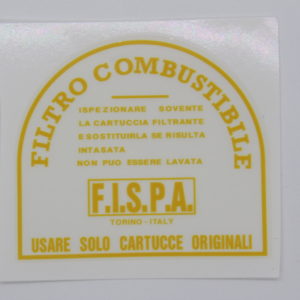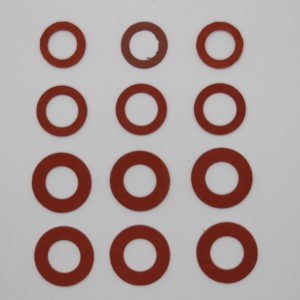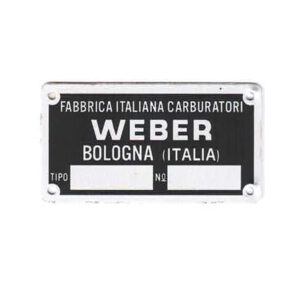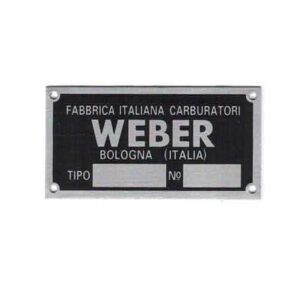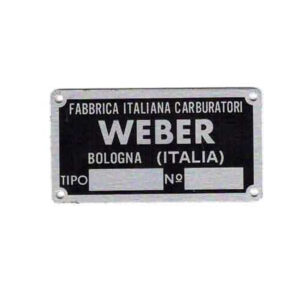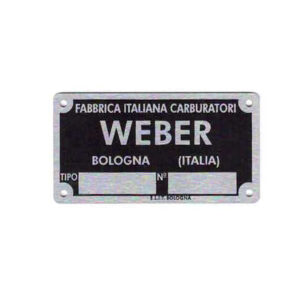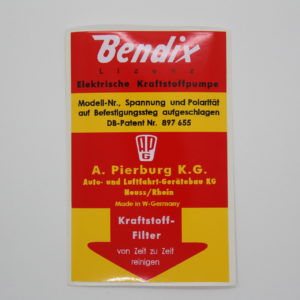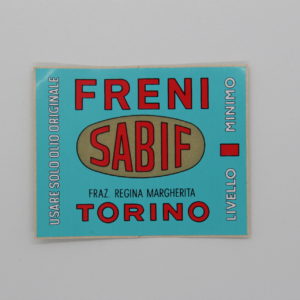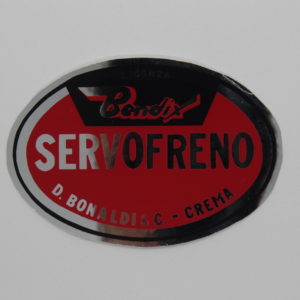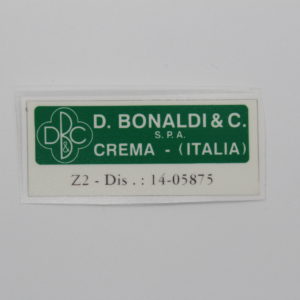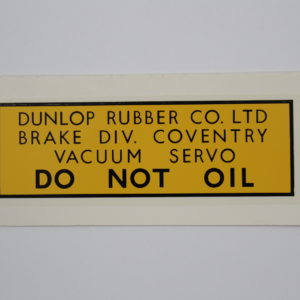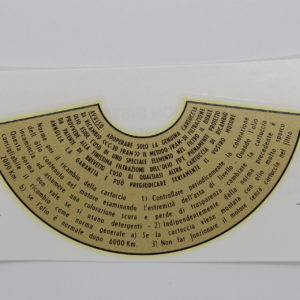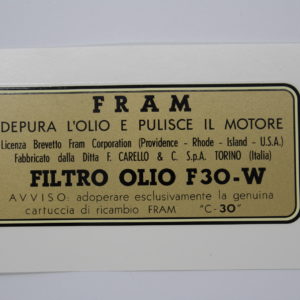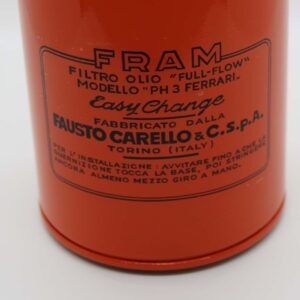Showing 73–96 of 258 results
-
54-1 | Yellow F.I.S.P.A decal (fispa letters clear in a yellow black)
$40.00With the electric fuel pumps there is a fuel filter also made by F.I.S.P.A. The filter element is contained in a steel bowl which is painted gray or an industrial green color which has a decal telling the mechanic to be sure to change the filter. These filters are always packed with mud and rust on the old cars. Be sure that the tank is near empty before removing the filter bowl. Yello F.I.S.P.A decal (FISPA letters clear in a yellow block)
(Sold Individually)
Product Search: Kil-54-1
Add to cart -
54-2 | Multicolored F.I.S.P.A
$25.00With the electric fuel pumps there is a fuel filter also made by F.I.S.P.A. The filter element is contained in a steel bowl which is painted gray or an industrial green color which has a decal telling the mechanic to be sure to change the filter. These filters are always packed with mud and rust on the old cars. Be sure that the tank is near empty before removing the filter bowl. Multicolored F.I.S.P.A. decal, used on cars near #1500
(Sold Individually)
Product Search: Kil-54-2
Add to cart -
54-3 | Yellow FISPA decal (FISPA letters printed in yellow on clear)
$20.00With the electric fuel pumps there is a fuel filter also made by F.I.S.P.A. The filter element is contained in a steel bowl which is painted gray or an industrial green color which has a decal telling the mechanic to be sure to change the filter. These filters are always packed with mud and rust on the old cars. Be sure that the tank is near empty before removing the filter bowl. Yellow FISPA decal(FISPA letters printed in yellow on clear background)
(Sold Individually)
Product Search: Kil-54-3
Add to cart -
57-1 | 9-piece red fiber washers for inside plug engines
$20.00Red fiber washers were used to seal the mating surfaces of the components on the fuel log and carburetors. These are all 12mm I.D.. Copper washers were also supplied with the Weber carburetor rebuild kits. Weber also supplied brass, unplated nuts, banjo bolts and other pieces as replacements. It is my opinion that the cars were delievered with the red fiber washers and with all of the fuel log components chrome-plated. 9-Piece Red Fiber Washers for Inside Plug Engines
Product Search: Kil-57-1
Add to cart -
57-2 | 12-piece red fiber washers for outside plug engines
$35.00Red fiber washers were used to seal the mating surfaces of the components on the fuel log and carburetors. These are all 12mm I.D.. Copper washers were also supplied with the Weber carburetor rebuild kits. Weber also supplied brass, unplated nuts, banjo bolts and other pieces as replacements. It is my opinion that the cars were delievered with the red fiber washers and with all of the fuel log components chrome-plated. 12-Piece Red Fiber Washers for Outside Plug Engines
Product Search: Kil-57-2
Add to cart -
59 | Bendix electrical fuel pumps
$30.00The 365 2+2s, Daytonas and C4s used dual Bendix electrical fuel pumps. This is a reproduction of the German Bendix fuel Pump sticker. Bendix Fuel Pump Sticker
(Sold Individually)
Product Search: Kil-59
Add to cart -
61 | “Livello” brake fluid sticker
$35.00The aluminum “Milk Bottle” brake reservoirs were inherited from the Fiat “Topolinos” and were used on a lot of the Ferraris in the mid to late 1950s, notably the T.R.s. On the Fiat Topolinos there were two decals, one with the Fiat brake fluid information and a second “Livello” decal indicating the correct level to fill the bottle. This one is white with red and green lettering. These stickers can be seen on the “King Leopold” chassis on page 30 of the Fitzgerald and Merritt book Ferrari, The Sports and Grand Tourisimo Cars. “Livello” Brake Reservoir Sticker
(Sold Individually)
Product Search: Kil-61
Add to cart -
62 | “Sabif” brake reservoir sticker
$40.00This one was on one of the 250MM Mexican Road Race cars from the early 1950s. The background information on this one is a little vague and I have not seen an original or a period photograph of one. “Sabif” Brake Reservoir Sticker
(Sold Individually)
Product Search: Kil-62
Add to cart -
63 | Bendix “servofreno” brake booster sticker
$35.00Mike Hawthron and Peter Collins were the top F1 drivers for Ferrari in 1958. Both had driven the “C” and “D” Type Jaguars with Dunlop disc brakes and tried to convince Enzo Ferrari to use them on his cars. Peter went as far as having the Dunlop disc brakes installed on his personal 250 P.F. Spyder #0655. Peter was killed in the German G.P. and the old Ferrari drum brakes were blamed for the accident. Mike Hawthorn insisted that Ferrari install disc brakes on the F1 cars for the last race in Morocco. At Casablanca Mike finished second to Stirling Moss but won the F1 championship by a single point. In the fall of 1959 Ferrari fitted Dunlop disc brakes on the SWB #1539 at the Paris show. They were quickly adopted on all of the street and competition cars. Ferrari chose to use a power booster made in Italy by Bonaldi under license of the U.S. Bendix company. The vacuum can was cadmium-plated, the cast aluminum components were left unpainted and the four hooks that attached the can were either cad-plated or had a black finish. The red “Servofreno” stickers were centered, front to rear on the can between the top vacuum line and the adjacent retaining hook. The stickers were positioned to be read from the front or “snout” end of the booster. Bendix Servofreno Booster Sticker
(Sold Individually)
Product Search: Kil-63
Add to cart -
64 | Vacuum hose for the bendix brake booster
$130.00The 250 series cars used a black ribbed rubber hose to connect a port on the rear intake manifold to the brake booster. These reproductions are based on a modern air conditioning hose and are heavily reinforced to avoid problems with collapsing due to the vacuum. This is an appropriate hose for the 250s. Some cars may have been fitted with a more conventional “cloth wrapped” rubber hose as used on the 275s and later cars. These hoses used Cheney clamps at each end. Ribbed 250 Vacuum Hose
Product Search: Kil-64
Add to cart -
65 | 275/330/365 Bonaldi green booster sticker
$40.00Bonaldi also made brake boosters for these later cars. The earlier ones, used as late as the Dayonas were a lighter color, like the color of grass. The later ones on late Daytonas were a lot darker, like hunter green. Green Bonaldi 275/330/365 Brake Booster Sticker
(Sold Individually)
Product Search: Kil-65
Read more -
66 | Dunlop brake booster sticker
$30.00Dunlop / Girling made most of the brake components and supplied the black brake boosters used on some of the 275 and 330 series cars. This is a water transfer decal, yellow background with black print. The correct brake booster for each car is listed on the build sheets. Dunlop Booster Decal
(Sold Individually)
Product Search: Kil-66
Add to cart -
68 | Small oil filter decal set
$70.00The early 250 series cars used a small catridge type oil filter built under license of the U.S. Fram Corporation. The small one is 4 3/4″ long and uses filter #CH6PI. These filters were used on cars built in the mid 1950s until about 1958. Set of Four Decals for the Short Cartridge – type Oil Filters
(Sold as a set, as pictured)
Product Search: Kil-68
Add to cart -
69-1 | Fram C-30 long filter top decal
$25.00At about the time of the introduction of the P.F. Coupes and Spyders Ferrari changed to the long (8″) type Fram oil filters. This type uses a Fram #C-30 filter element and there is a decal on the top and another one on the side of the can. These are water transfer decals and the top one is very difficult to install due to the compound curve of the top. I recommend that you remove the filter top from the car, soak the filter in a pan of warm water, remove the decal from the backing paper as soon as it will slide, then carefully position it on the top. Fram C-30 Long Filter Top Decal
(Sold Individually)
Product Search: Kil-69-1
Read more -
69-2 | Fram C-30 long filter top decal
$25.00At about the time of the introduction of the P.F. Coupes and Spyders Ferrari changed to the long (8″) type Fram oil filters. This type uses a Fram #C-30 filter element and there is a decal on the top and another one on the side of the can. These are water transfer decals and the top one is very difficult to install due to the compound curve of the top. I recommend that you remove the filter top from the car, soak the filter in a pan of warm water, remove the decal from the backing paper as soon as it will slide, then carefully position it on the top. Fram C-30 Long Filter Top Decal
(Sold Individually)
Product Search: Kil-69-2
Read more -
70K | PH3 oil filter with valve
$100.00When the new “outside plug 250 engines” were introduced Ferrari changed to the more modern spin-on type filters, again from the FRAM Company. These filters include the silk-screened sticker with correct information on the outside plug engines.
NOTE:
We are now offering all filter combinations with or without inner valve and 4 sticker options, so you are responsible for ordering what if correct for your needs.
This part number KIL-70K is for a B50 filter painted correct FRAM orange color with flow control valve and finished with the FRAM PH3 sticker (applied).
These filters are sold individually and are NOT RETURNABLE as the are made to order. So again, please make sure you are ordering correctly as to what you need.
Add to cart




